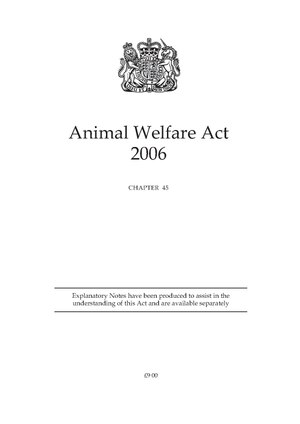Animal Welfare Act 2006: Difference between revisions
No edit summary |
No edit summary |
||
| Line 1: | Line 1: | ||
[[Category:Animal law]] | [[Category:Animal law]] | ||
[[Category:United Kingdom]] | [[Category:United Kingdom]] | ||
[[File:Animal Welfare Act 2006.pdf|alt=Animal Welfare Act 2006|thumb|'''Animal Welfare Act 2006''']] | [[File:Animal Welfare Act 2006.pdf|alt=Animal Welfare Act 2006|thumb|'''Animal Welfare Act 2006''']] | ||
Latest revision as of 11:22, 28 November 2023

The Animal Welfare Act 2006 is the principal law in England and Wales that relates to animal welfare.[1] It was introduced to promote the welfare of vertebrate animals, excluding those in the wild.[2] The Act is significant as it introduced a new concept for pet owners and those responsible for domestic animals, such as breeders and those who have working or farm animals.[3]
The Act places a duty of care on people to ensure they take reasonable steps to meet the welfare needs of their animals to the extent required by good practice.[3] This means that they must provide for the five welfare needs of the animals, which are:
- Need for a suitable environment
- Need for a suitable diet
- Need to be able to exhibit normal behaviour patterns
- Need to be housed with, or apart, from other animals
- Need to be protected from pain, suffering, injury and disease
The Act allows enforcement agencies and inspectors to act by advising and educating owners before their pets suffer.[3] If this advice is not followed or the animal’s needs are not being met, then action can be taken, whether through a formal warning or in some cases a prosecution.[3]
See also
- Newshound: Animal Welfare Act 2006
- Animal Hub: Animal Law
External links
- Animal Welfare Act 2006 GOV.UK
- Overview of UK Animal Protection Legislation Michigan State University College of Law
References
- ↑ Guidance Animal welfare gov.uk
- ↑ Animal Welfare Act 2006 legislation.gov.uk
- ↑ 3.0 3.1 3.2 3.3 Animal Welfare Act RSPCA
